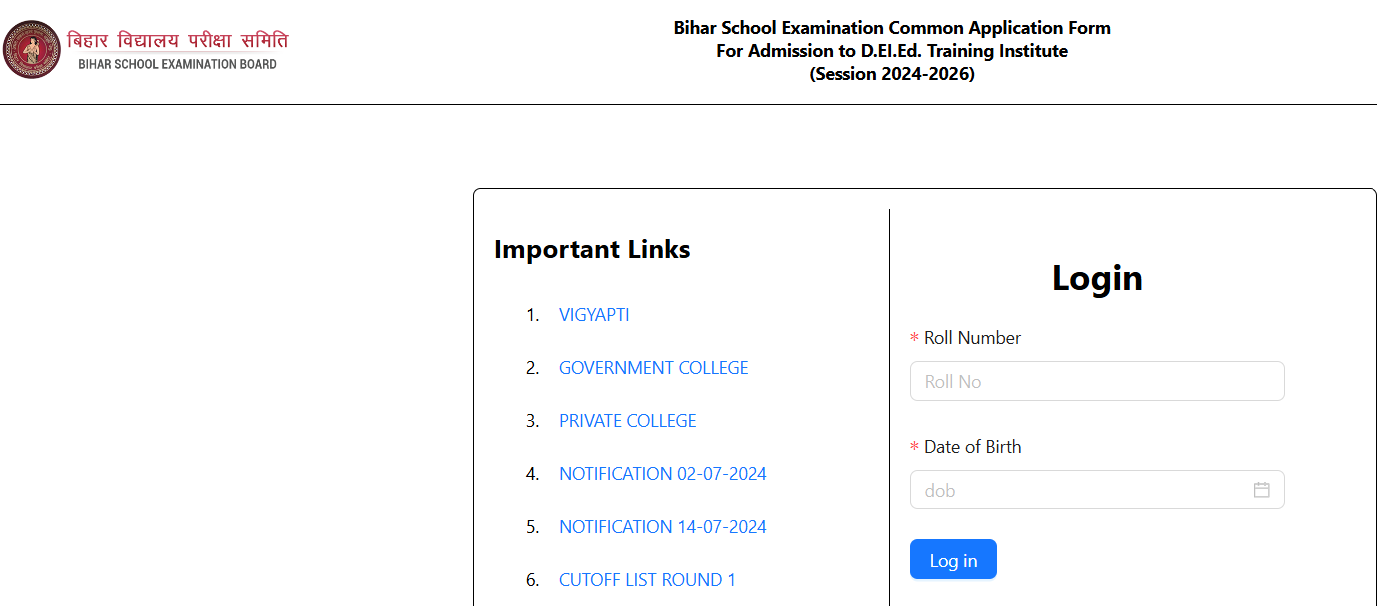Bihar School Examination Board (BSEB)
10+2 (Intermediate) Commerce and Arts Syllabus
Click here to Check 10th Dummy Registration Card 2021
Click here to Check 12th Dummy Registration Card 2021
www.studyihar.in
The Students who are looking for the Syllabus of Commerce and Arts Streams of Intermediate for their Study are notified that here is the Syllabus of All Subject of I.Com and I.A Course of .Accountancy, Economics, Entrepreneurship, Business, Hindi, English, History, Political Science, Geography, Sociology, Philosophy, Psychology
Click here to See 12th Science Stream Syllabus
Bihar Board Intermediate/12th Commerce Syllabus 2020
| S.No | Subjects |
| 1 | Business Study |
| 2 | Accountancy |
| 3 | Entrepreneurship |
| 4 | Economics |
| 5 | English |
| 6 | Hindi |
Bihar Board 12th/Intermediate Syllabus 2020 for Accountancy
| Name of the Unit | Topics |
| Introduction to Partnership | 1.1 Meaning and definitions
1.2 The Indian partnership Act 1932 1.3 Methods of capital accounts
|
| Partnership Final Accounts | 2.1 Introduction and Necessity of preparation of Final Accounts with the following adjustments.
|
| Reconstitution of Partnership | 3.1 Meaning and different ways of reconstitution
3.2 Admission of a partner 3.2.1 Meaning and Need 3.2.2 Capital brought by a new partner 3.2.3 New profit sharing ratio 3.2.4 Sacrifice ratio 3.2.5 Goodwill – Meaning, Methods of valuation and treatment of goodwill.
3.2.6 Adjustment of accumulated profits and losses. 3.2.7 Revaluation of assets and liabilities 3.2.8 Adjustment of capitals 3.3 Retirement / Death of a partner 3.3.1 Meaning, need 3.3.2 New ratio 3.3.3 Gain ratio 3.3.4 Treatment of goodwill 3.3.5 Adjustment of accumulated profits and losses 3.3.6 Revaluation of assets and liabilities 3.3.7 Adjustment of capital 3.3.8 Amount due to retiring partner 3.3.9 Death of partner |
| Dissolution of Partnership Firm | 4.1 Simple dissolution, 4.2 Dissolution under Insolvency situation |
| Accounts of Not for Profit concerns | 5.1 Introduction, meaning, and features of Not for Profit concerns.
5.2 Receipts and Payments Account meaning and features. The distinction between Income and Expenditure account. 5.3 Preparation of Income and Expenditure Account and Balance Sheet with the following a) Additional Information
b) Important Items: Entrance fees, Subscriptions, Legacy, life membership fees, Sale of old assets, Scrap, Newspapers, Specific donation, General Donations, Specific Funds, Endowment fund |
| Single entry system | 6.1 Introduction
6.2 Preparation of statements 6.3 Additional information.
|
| Bill of Exchange (Only Trade Bill) | 7.1 Introduction, necessity, Meaning, Definition of Bill of Exchange
7.2 Draft/format of Bills, Parties to the Bill of Exchange, Acceptance of Bill, Terms of Bill, Days of Grace, Date of maturity, Due Date, Types of Bill 7.3 Honouring of Bill, Dishonour of Bill, Noting and Protesting of Bill, Notary Public and Noting Charges 7.4 Accounting Treatment of Bill by the Drawer/Holder and Drawee in
|
| Company Accounts Part-I Accounting for shares | 8.1 Share and share capital, Meaning, Nature and Types.
8.2 Accounting for Share Capital: Issue and Allotment of Equity Shares. Private placement of shares. Public subscription of shares. Oversubscription and Under subscription of shares. The issue at Par and premium, and at discount, Calls in advance in arrears, Issue of shares for consideration other than cash. 8.3 Accounting treatment of forfeiture and re-issue 8.4 Disclosure of Share capital in the Company’s Balance Sheet (Horizontal form) |
| Company Accounts Part-II Accounting for Debentures | 9.1 Debentures: Meaning, Issue of debentures at par, at a premium and at discount
9.2 Issue of debentures for consideration other than cash. Interest on Debentures. |
| Analysis of financial statements | 10.1 Financial statement Analysis: meaning, objectives and limitations.
10.2 Tools for financial statement Analysis-meaning of comparative statements, common-size statements, cash flow analysis, and Ratio analysis. 10.3 Accounting Ratios: Meaning of objectives and classification of Ratios. 10.4 Introductions to current ratio, liquid ratio, Gross profit ratio, operating profit ratio, and Net profit ratio. ROI, ROCI |
Bihar Board 12th/Intermediate Syllabus 2020 for Economics
| Name of the Unit | Topics |
| Section A: Micro Economics |
|
| Section B: Macro Economics |
|
Bihar Board 12th/Intermediate Maths Syllabus 2020 for Commerce Stream
| Name of the Unit | Topics |
|
Mathematical logic
|
1.1 Statements1.2 Logical Connectives
1.3 Statement patterns and logical equivalence 1.4 Algebra of statements 1.5 Venn diagrams |
| Matrices | 2.1 Definition and types of matrices2.2 Algebra of matrices
2.3 Inverse of a matrix 2.4 Solution of equations |
| Continuity | 3.1 Continuity of a function at a point |
|
Differentiation
|
4.1 Derivative of Inverse function4.2 Logarithmic Differentiation
4.3 Derivative of an implicit function 4.4 Derivative of a parametric function 4.5 Second order derivative |
| Applications of Derivative | 5.1 Increasing and decreasing functions5.2 Maxima and minima |
|
Indefinite Integration
|
6.1 Definition of an integral6.2 Integral of standard functions
6.3 Rules of Integration 6.4 Methods of Integration 6.5 Integration by parts |
| Definite Integrals | 7.1 Definite Integral7.2 Properties
7.3 Applications |
| PART – II | |
| Ratio, Proportion and Partnership | Ratio, proportion and partnership |
| Commission, Brokerage and Discount | 2.1 Commission and Brokerage
2.2 Discount |
| Insurance and Annuity | 3.1 Insurance
3.2 Annuity |
| Demography | 4.1 Introduction, Definition4.2 Uses of vital statistics
4.3 Measurements of Mortality 4.4 Life tables |
| Bivariate Data and Correlation | 5.1 Bivariate frequency distribution
5.2 Karl Pearson’s coefficient of correlation 5.3 Rank correlation |
| Regression Analysis Introduction | 6.1 Equation of line of regression
6.2 Regression coefficients and their properties. |
Bihar Board 12th Arts Syllabus 2020
The Bihar board 12th arts syllabus pdf was released by the Bihar board on its official websites for the subjects given in the table below.
| S.No | Subjects |
| 1 | History |
| 2 | Political Science |
| 3 | Geography |
| 4 | Economics |
| 5 | Sociology |
| 6 | Psychology |
| 7 | Philosophy |







